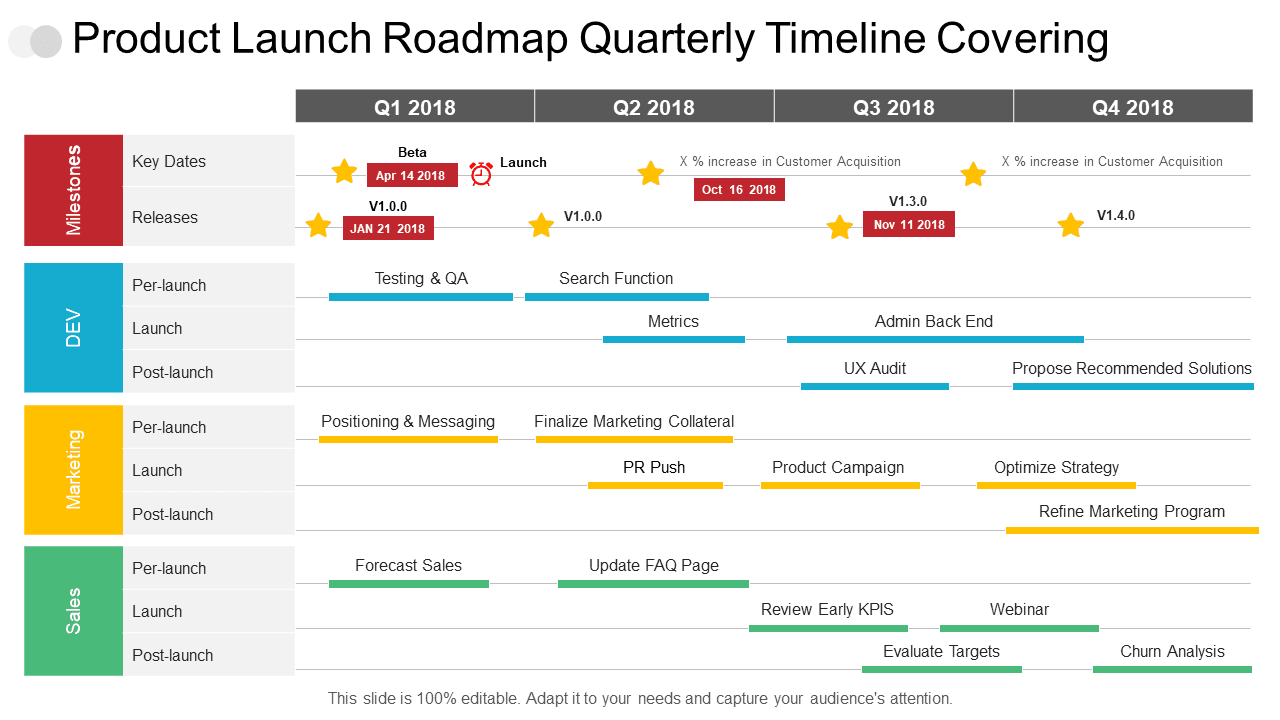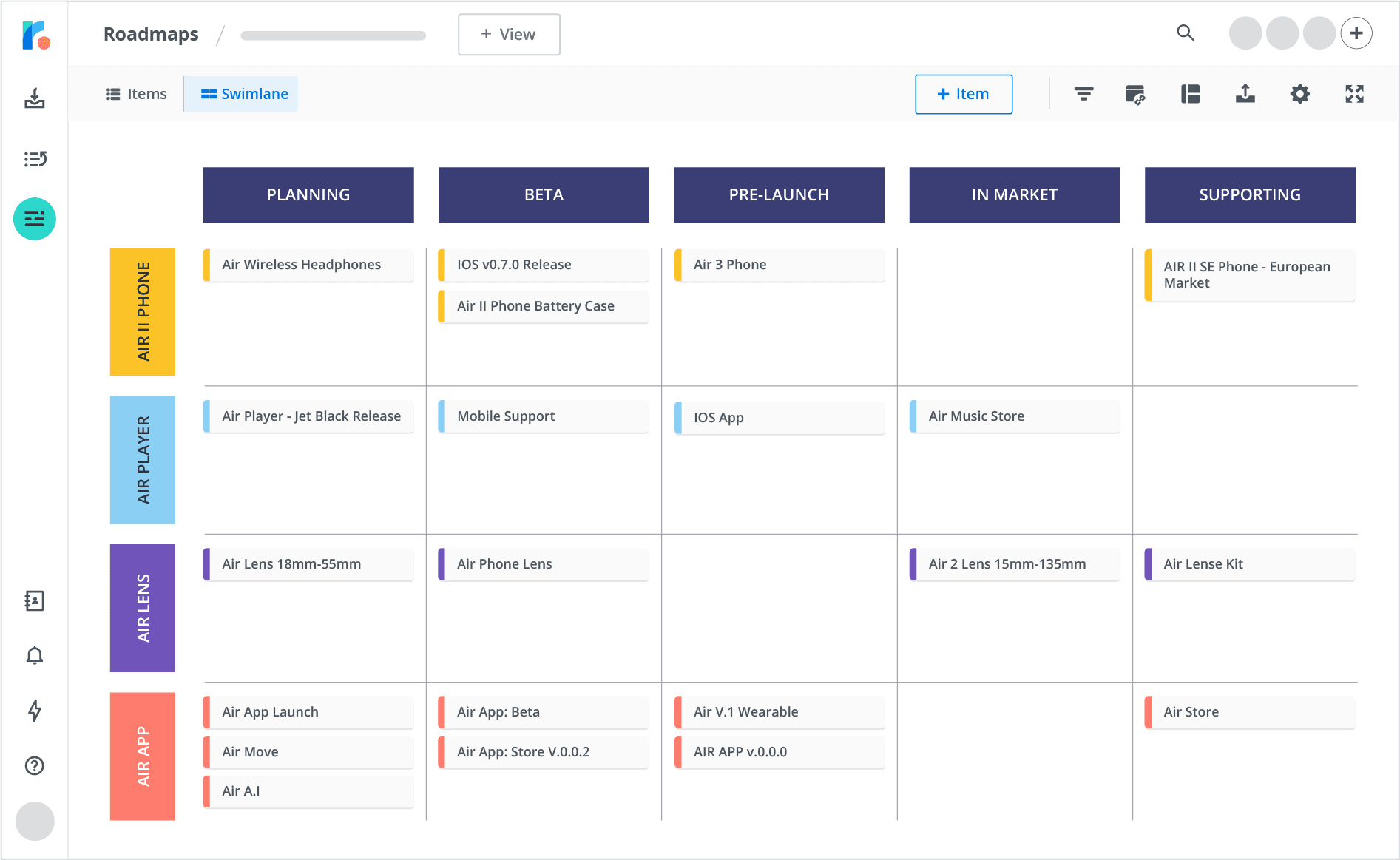Updated: January 10, 2025- 23 min read
Creating a product roadmap isn't just a good idea—it's essential. Look around the web and you’ll notice a hoard of experienced product managers saying that there’s no success without a detailed roadmap.
To help you craft a roadmap that leads to triumph, we've gathered 7 expert-vetted examples you can adopt. Each offers a unique insight into their development processes and upcoming innovations.
Each roadmap is designed to streamline your planning process and keep your team aligned and focused. Dive in and find the perfect product roadmap example to elevate your product strategy. First, though, let’s walk you through the essentials…
Product Roadmap Template
Download our easy-to-use template to help you create your Product Roadmap.
Get the Template
What Is a Product Roadmap?
"You are on a trajectory. You have assets. You have liabilities. You have a vision — 2, 3, 5 years from now. But, you need to chapterize it." — Fabrice des Mazery, former CPO at TripAdvisor, in Product Podcast
A product roadmap is a strategic document that outlines the vision, direction, and progress of a product over time. An essential artifcat in the product management process, it serves as a guiding framework that aligns the entire team with the product's goals and milestones.
The concept of roadmapping originated in the tech industry in the late 20th century, as companies needed a way to manage complex product development cycles. Initially, roadmaps were simple charts or lists that plotted out major product releases. Today, they have evolved into dynamic tools that integrate real-time data and adapt to market changes.
In modern business, a product roadmap is more than just a timeline. It’s a narrative that details the journey from your current state to your desired future. It ensures a coordinated team effort, helps in managing assets and liabilities, and in chapterizing your vision into actionable steps. This strategic approach ensures that every team member understands the path ahead and how their contributions fit the bigger picture.
What Should a Product Roadmap Include?
There isn’t a one-size-fits-all product roadmap. Its appearance can vary greatly based on a team’s specific goals and needs. There’s a science to navigating product roadmaps, of course, but every team adds their own touch to the equation. However, product managers typically include several common elements in their agile product roadmap samples:
Product Vision and Goals: This outlines the high-level strategic plan for your product, detailing the 'why' behind your efforts. It sets the overall direction and objectives you aim to achieve.
Product Initiatives: These are major efforts or projects designed to help you meet your goals. Initiatives often involve multiple teams and are broken down into epics or user stories.
Features and Enhancements: These are the particular functionalities and improvements you plan to incorporate into your product. Each feature should align with an initiative and ultimately support the product goals.
A Rough Timeline: This is an estimated schedule for when each feature or initiative will be completed. Some roadmaps may include specific dates, while others use broader timeframes such as Q1, Q2, etc.
Status Updates: These provide progress reports on initiatives and features, helping stakeholders understand the current state of development and where there may be delays or changes.
Key Metrics: These define how success will be measured, which could include KPIs or specific targets you aim to reach with your initiatives.
Stakeholders: This identifies the key stakeholders involved, including internal teams, customers, or external partners.
Product Roadmap Example #1: Feature Roadmap
A feature roadmap is a tool that details the development and release schedule of product features over time. It helps teams and stakeholders visualize and align on upcoming work. Think of it as the Minimum Viable Product Roadmap: simple, straightforward, and effective in getting the job done without unnecessary complexity.

Download the Feature Roadmap template here.
To build a Feature Roadmap, you should define clear objectives:
Align with Product Vision:
Example: If your product aims to simplify project management for small businesses, each feature should contribute towards this goal, like adding intuitive task assignments or budget tracking functionalities.
Tip: Create a product vision board to constantly remind the team of the overarching goals and user needs.
Prioritize Features:
Example: Use a prioritization matrix (a tool to rank features based on criteria like impact and effort) to evaluate and rank features.
Tip: Consider the Kano Model (a method to categorize features into basic needs, performance enhancers, and delighters) to make balanced prioritization decisions.
Organize Features:
Categorize by Themes:
Example: Group features under themes such as “User Experience Improvements,” “Security Enhancements,” and “New Integrations.”
Tip: Themes can help focus development sprints and align marketing efforts around cohesive updates.
Timeline and Releases:
Example: Use a Gantt Chart (a visual representation of a project schedule) to represent the timeline of feature development, showing dependencies and milestones.
Tip: Plan buffer time in your releases to accommodate unexpected delays and ensure smoother launches.

Collaborate with Stakeholders:
Gather Feedback:
Example: Conduct user research, surveys, and user testing sessions to gather diverse input on feature priorities.
Tip: Use feedback collection tools like user feedback platforms (software that gathers and organizes user input) or project management boards for collecting and organizing user feedback in a structured manner.
Regular Syncs:
Example: Schedule bi-monthly stakeholder meetings, strategy roundups, or agile retrospectives to review progress and adjust priorities based on the latest insights.
Tip: Use collaboration tools like team communication platforms (software that facilitates ongoing team communication) to keep communication ongoing and transparent.
Use Roadmapping Tools:
Select Appropriate Tools:
Example: Use tools that facilitate interactive and visually appealing roadmaps.
Tip: Choose tools that integrate well with your existing project management software to streamline updates.
Enhance Visual Clarity:
Example: Use different colors for features in the development, testing, and launch plan phases.
Tip: Incorporate icons to represent feature categories (e.g., user-facing, backend) and labels for quick reference.
Monitor and Adapt:
Track Development:
Example: Implement a dashboard (a visual display of key metrics and progress) that tracks feature progress, key metrics, and blockers in real time.
Tip: Regularly review performance metrics and user feedback post-launch to iterate on features.
Stay Flexible:
Example: Use Agile methodologies (a flexible approach to project management with regular iterations) to remain adaptable, with regular sprint reviews and planning sessions.
Tip: Maintain a backlog (a prioritized list of features and tasks) of potential features and improvements to quickly pivot when market conditions change or new insights emerge.
Example #2: Agile Roadmap
An Agile Product Roadmap is a flexible plan that provides a high-level overview of product goals and initiatives, adapting over time to reflect changes in priorities, customer needs, and market conditions. It helps teams visualize how they will implement Agile product management best practices, such as iterating rapidly and delivering value continuously while ensuring alignment with the overall product strategy.

What to Include in an Agile Product Roadmap:
1. Product Vision and Goals
Define the Product Vision: Articulate the long-term vision of the product, ensuring that the team and stakeholders understand the purpose behind the product.
Example: Create a product that simplifies project management for small businesses.
Tip: Align the product vision with key business objectives to ensure that everyone is working towards the same goals.
Set Short-Term Goals: Establish achievable goals for each sprint or release cycle that help move the product closer to the overall vision.
Example: Improve user onboarding to increase engagement by 15% in the next quarter.
Tip: Use frameworks like OKRs (Objectives and Key Results) to keep goals specific and measurable.
2. Themes, Epics, and User Stories
Define Themes, Epics, and User Stories: Group related features and initiatives into themes or epics, and break them down further into user stories that provide a clear understanding of product priorities and customer needs.
Example: A theme might be "Enhance User Experience," which includes epics like improving navigation, simplifying account settings, and refining search functionality. These epics can be broken into user stories such as "As a user, I want an intuitive navigation menu so that I can easily find features."
Tip: Keep themes broad to allow flexibility in how to achieve them while ensuring they align with the product vision.
Prioritize Based on Value: Prioritize themes, epics, and user stories based on customer value, market needs, and resource availability.
Example: Focus on features that directly address customer pain points to drive adoption.
Tip: Use a prioritization framework like MoSCoW (Must-have, Should-have, Could-have, Won't-have) to rank items effectively.
Plan Regular Releases: Develop a cadence for releasing updates to deliver value frequently, even if a complete feature is not finished.
Example: Release an MVP (Minimum Viable Product) feature to gather early feedback.
Tip: Use continuous deployment to frequently deliver small improvements.
3. Cross-Functional Team Planning
Development, Product, UX, and QA Alignment: Organize the roadmap into key areas such as Development, Product, UX, and QA to ensure cross-functional alignment and visibility.
Example: In Sprint 1.2, Development might focus on "Back-end engine" and "Feature A scope," while Product works on "Roadmap brief" and "Feature requirements."
Tip: Use clearly defined rows for each function to visualize dependencies and promote collaboration.
Coordinate Sprint Goals Across Teams: Ensure that each sprint is clearly defined across different functional areas, including Development, Product, UX, and QA, to keep everyone on the same page.
Example: In Sprint 1.3, Product focuses on "Pilot" and "Feedback," while UX works on "Feature-level design" and QA performs "Variance testing."
Tip: Use tools like Jira or Trello or Product School's free roadmap templates to assign tasks to each functional team, ensuring synchronization across sprints.
4. Customer and Market Feedback
Gather and Incorporate Feedback: Continuously collect customer feedback to adjust priorities and ensure product features align with user needs.
Example: Run beta tests and surveys after each release to gather insights on new features.
Tip: Set up a feedback loop through tools like in-app surveys to get real-time customer responses.
Adapt to Market Changes: Use insights from market analysis to stay informed about competitors and adapt the roadmap as needed.
Example: Adjust priorities based on emerging industry trends that require a shift in focus.
Tip: Set aside regular time for market review meetings to stay on top of industry shifts.
5. Iteration and Flexibility
Embrace Iteration: Continuously iterate on the roadmap to reflect learnings from sprints, customer feedback, and market changes.
Example: Update the roadmap at the end of each sprint based on the results of retrospectives.
Tip: Treat the roadmap as a living document that evolves alongside the product.
Plan for Change: Keep the roadmap flexible to accommodate new opportunities or pivots when needed.
Example: Quickly reprioritize features if a major customer need emerges.
Tip: Use lightweight documentation and avoid over-planning to maintain agility.
Example #3: Product Development Roadmap
A Product Development Roadmap offers a high-level view of the entire product management process, covering all stages from initial concept to final launch and beyond. It includes strategic planning and outlines the product's long-term vision. Product development presents unique challenges, so it needs a tailored roadmapping approach.
What to Include in a Product Development Roadmap:
Discovery Phase:
User Research: Plan how you’ll conduct user interviews, surveys, and usability tests to understand user needs, pain points, and preferences.
Example: Conduct user interviews to gather detailed insights on user behavior and preferences.
Tip: Use online survey tools to collect and analyze user feedback efficiently.
Market Research: Include analysis of market trends, competitors, and industry standards to identify opportunities and threats.
Example: Perform a SWOT (Strengths, Weaknesses, Opportunities, Threats) analysis to evaluate the competitive landscape.
Tip: Subscribe to industry reports and newsletters to stay updated on market trends.
Idea Generation: Brainstorm and collaborate with cross-functional teams, stakeholders, and user feedback to include in the roadmap.
Example: Organize a brainstorming session with key stakeholders to generate innovative ideas.
Tip: Use idea management software to collect and prioritize ideas.
Planning and Prioritization:
Higher-order Planning: Develop a high-level roadmap outlining key milestones, phases, and deliverables.
Example: Create a project timeline with key milestones such as concept development, prototyping, and final testing.
Tip: Use Gantt Charts to visualize the project timeline and dependencies.
Set Priorities: Prioritize features and tasks based on impact, user needs, and strategic alignment.
Example: Use a prioritization matrix (a tool to rank features based on criteria like impact and effort) to evaluate and rank features.
Tip: Consider the Kano Model (a method to categorize features into basic needs, performance enhancers, and delighters) to make balanced prioritization decisions.
Break Down the Development Process:
Sprint Planning: Break down the roadmap into sprints or development cycles, assigning tasks to teams.
Example: Plan two-week sprints with specific tasks and deliverables for each cycle.
Tip: Use Agile project management tools to plan and track sprints.
Agile Development: Implement agile methodologies (iterative development cycles) to iteratively develop, test, and refine the product.
Example: Conduct daily stand-up meetings to ensure team motivation, alignment and progress.
Tip: Adopt Scrum or Kanban frameworks to manage agile development processes.
Continuous Integration: Use continuous integration practices to ensure frequent testing and integration of new code.
Example: Automate code integration and testing using CI/CD pipelines (continuous integration and continuous deployment).
Tip: Use version control systems to manage code changes and integrations.
Testing and Quality Assurance:
Create Prototypes: Develop low-fidelity prototypes or mockups to visualize and test initial concepts.
Example: Use wireframing tools to create mockups and prototypes for user testing.
Tip: Involve users in prototype testing to gather early feedback and refine designs.
Automated Testing: Implement automated testing to quickly identify and fix issues.
Example: Use automated testing frameworks to run tests on each code commit.
Tip: Integrate automated testing into the CI/CD pipeline for continuous quality assurance.
User Testing: Conduct extensive user research to validate ideas, gather feedback, and ensure the product meets user needs.
Example: Organize beta testing sessions with a group of target users.
Tip: Use feedback tools to collect and analyze user feedback during testing.
Bug Fixes and Improvements: Continuously address bugs and make improvements based on testing results.
Example: Maintain a bug tracker to log and prioritize issues for resolution.
Tip: Schedule regular bug triage meetings to review and address reported issues.
Launch and Post-Launch:
Prepare for Launch: Develop a launch strategy and a launch plan, including marketing, communication, and support strategies.
Example: Create a comprehensive launch checklist covering all aspects of the product release.
Tip: Coordinate with marketing and support teams to ensure a smooth product launch.
Monitor Performance: Track key metrics, OKRs and KPIs, and user feedback to assess the product’s performance and adoption.
Example: Use analytics tools to monitor user engagement and product usage.
Tip: Set up dashboards to visualize and track key performance indicators (KPIs).
Iterate and Improve: Use post-launch data to inform future development cycles and make necessary improvements.
Example: Schedule regular post-launch reviews to gather insights and plan future updates.
Tip: Continuously engage with users to collect feedback and identify improvement opportunities.
Example #4: Outcome-based Roadmap
An Outcome-Based Roadmap focuses on achieving specific goals rather than detailing every feature or release date. Instead of listing individual tasks, it groups initiatives into themes and ties them to clear outcomes and key metrics. This approach allows for more flexibility and alignment with strategic goals.

Download the Outcome-based Roadmap template here.
How to Create an Outcome-based Roadmap:
Group Initiatives into Themes that Support the Product Vision:
Identify Core Themes: Begin by identifying core themes that align with your product vision. These could be product experience improvements, technical debt reduction, or market expansion.
Example: Identify themes such as "User Experience Enhancements," "Performance Optimization," and "Market Expansion."
Tip: Ensure themes are broad enough to encompass multiple initiatives but specific enough to provide clear direction.
Categorize Initiatives: Group upcoming initiatives under these themes. For example, features improving user onboarding fall under "User Experience."
Example: Group features like "Improved Onboarding Process" and "Enhanced User Interface" under the "User Experience" theme.
Tip: Use a visual mapping tool to categorize and organize initiatives under relevant themes.
Tie Themes to Specific Outcomes:
Define Desired Outcomes: For each theme, define clear, desired outcomes. What change do you expect to see? Example: "Increase user retention by 15%."
Example: Define outcomes such as "Reduce customer churn by 20%" and "Improve feature adoption rate by 30%."
Tip: Use product analysis to track progress and assess the impact of each initiative.
Outcome Alignment: Ensure each initiative within a theme directly contributes to achieving the defined outcome. This ensures all efforts are focused and coherent.
Example: Align initiatives like "New User Tutorial" and "In-app Help Center" with the outcome of "Enhancing User Engagement."
Tip: Regularly review and validate the alignment of initiatives with their respective outcomes.
Align Themes with Key Metrics:
Set Clear Goals: Establish measurable goals that support your product vision. These goals should be SMART (Specific, Measurable, Achievable, Relevant, Time-bound).
Example: Set goals such as "Increase monthly active users by 25%" or "Achieve a customer satisfaction score of 90%."
Tip: Break down larger goals into smaller, manageable objectives for better tracking.
Link to Key Metrics: Identify key metrics that will track progress towards these goals. For example, for a goal of "Improve customer satisfaction," a key metric might be Net Promoter Score (NPS).
Example: Track metrics like "User Retention Rate," "Feature Usage Frequency," and "Customer Lifetime Value."
Tip: Use analytics tools to continuously monitor and report on key metrics.
Continuous Review and Adaptation:
Regularly Review Roadmap: Periodically review and adjust the roadmap based on performance data and changing market conditions. Ensure it remains aligned with strategic goals.
Example: Schedule quarterly roadmap and business reviews to evaluate progress and make necessary adjustments.
Tip: Involve key stakeholders in review meetings to gather diverse perspectives and insights.
Stakeholder Feedback: Incorporate feedback from stakeholders to refine themes and outcomes, ensuring they remain relevant and impactful.
Example: Conduct stakeholder workshops to gather input and align on roadmap priorities.
Tip: Use feedback tools to collect and analyze stakeholder input efficiently.
Example #5: Now-Next-Later Roadmap

The Now-Next-Later Roadmap blends the strategic focus of Outcome-based Roadmaps with the flexibility of Agile Roadmaps, enabling quick adjustments. It emphasizes timing and prioritization by categorizing features into immediate, near-term, and future initiatives, unlike standard feature or outcome-based roadmaps.
Best Practices:
Define and Categorize Initiatives:
Identify Key Initiatives: Determine the key initiatives or features that need to be addressed.
Example: Identify key initiatives like "Implement User Authentication," "Enhance Search Functionality," and "Optimize Performance."
Tip: Focus on high-impact initiatives that align with strategic goals and user needs.
Categorize: Sort these initiatives into three categories: Now, Next, and Later.
Example: Categorize "Implement User Authentication" as Now, "Enhance Search Functionality" as Next, and "Optimize Performance" as Later.
Tip: Use a visual tool to create a clear and easy-to-understand categorization of initiatives.
Organize the Roadmap:
Now: Focus on the most immediate, high-priority tasks that are currently being worked on.
Example: Tasks like "Fix Critical Bugs" and "Deploy New Release" fall under the Now category.
Tip: Ensure that Now initiatives are well-defined and have clear, actionable steps.
Next: Plan the upcoming initiatives that are scheduled for the near term, after current tasks are completed.
Example: Next initiatives might include "Develop New Feature X" and "Conduct User Testing for Feature Y."
Tip: Prioritize Next initiatives based on their potential impact and feasibility.
Later: Outline longer-term initiatives that are important but not immediately actionable.
Example: Later initiatives could be "Explore Integration with Third-Party Service" and "Revamp User Interface Design."
Tip: Keep track of Later initiatives to revisit and re-prioritize as conditions change.
Align with Strategic Outcomes:
Set Clear Goals: Ensure each initiative is tied to specific, measurable outcomes that support strategic goals.
Example: Tie the initiative "Enhance Search Functionality" to the outcome "Improve User Search Satisfaction by 20%."
Tip: Use outcome-based planning to ensure that all initiatives contribute to the overall product strategy.
Prioritize Based on Impact: Prioritize initiatives based on their potential impact and alignment with overall product strategy. Use a prioritization method that considers impact such as Weighted Shortest Job First (WSJF).
Example: Use WSJF to prioritize initiatives by calculating the value of each feature divided by its complexity.
Tip: Regularly review and adjust priorities based on new data and insights.
Maintain Flexibility:
Iterative Updates: Regularly update the roadmap to reflect changes in priorities, market conditions, and feedback.
Example: Hold quarterly roadmap review meetings to assess progress and make necessary adjustments.
Tip: Use agile principles to ensure the roadmap remains flexible and responsive to change.
Adapt to Feedback: Be prepared to move items between Now, Next, and Later categories as needed based on new information and stakeholder input.
Example: Move "Optimize Performance" from Later to Now if performance issues become critical.
Tip: Keep communication channels open with stakeholders to gather ongoing feedback and insights.
Example #6: Product Launch Roadmap
A Product Launch Roadmap provides a detailed plan for bringing a product to market, covering all stages from pre-launch preparation to post-launch activities. It ensures that all teams are aligned and that the product launch process is smooth and successful.

Source: SlideTeam
What to Include in a Product Launch Roadmap:
Pre-Launch Preparation:
Market Research: Conduct thorough market research to understand the target audience, competitors, and market needs.
Example: Use surveys and focus groups to gather insights on customer preferences and pain points.
Tip: Analyze competitor products to identify gaps and opportunities in the market.
Product Positioning: Define the product's unique value proposition and positioning in the market.
Example: Create a positioning statement that highlights the product’s key benefits and differentiators.
Tip: Use SWOT analysis (Strengths, Weaknesses, Opportunities, Threats) to refine product positioning.
Marketing Strategy: Develop a comprehensive marketing plan that outlines key tactics for reaching the target audience.
Example: Plan social media campaigns, email marketing, and PR activities to build awareness.
Tip: Create a content calendar to organize and schedule marketing activities.
Planning and Coordination:
Set Launch Date: Establish a realistic and strategic launch date based on market conditions and internal readiness.
Example: Choose a launch date that avoids major holidays or competitor launches.
Tip: Coordinate with sales, support, and other teams to ensure everyone is prepared for the launch.
Internal Readiness: Ensure all internal teams are prepared and aligned with the launch plan.
Example: Conduct training sessions for sales and support teams to familiarize them with the product.
Tip: Use checklists to track readiness across different departments.
Execution:
Launch Event: Plan and execute a launch event to create buzz and excitement around the product.
Example: Host a virtual launch event with live demonstrations and Q&A sessions.
Tip: Leverage influencers and industry experts to amplify the event’s reach.
Marketing Campaign: Implement the go-to-market strategy to promote the product and drive user acquisition.
Example: Launch a targeted social media ad campaign to reach potential customers.
Tip: Use A/B testing to optimize ad creatives and messaging for better performance.
Sales Enablement: Provide sales teams with the tools and resources they need to effectively sell the product.
Example: Create sales kits, demo scripts, and FAQs to support the sales team.
Tip: Use CRM tools to track and manage leads generated from launch activities.
Post-Launch Activities:
Monitor Performance: Track key metrics and user feedback to assess the product’s performance and adoption.
Example: Use analytics tools to monitor user engagement, retention, and sales metrics.
Tip: Set up dashboards to visualize and track key performance indicators (KPIs).
Customer Support: Ensure the support team is prepared to handle any issues or questions from customers.
Example: Create a knowledge base with FAQs and troubleshooting guides.
Tip: Use customer feedback to continuously improve support resources and processes.
Iterate and Improve: Use post-launch data to inform future development cycles and make necessary improvements.
Example: Schedule regular post-launch reviews to gather insights and plan updates.
Tip: Continuously engage with users to collect feedback and identify improvement opportunities.
Example #7: Product Portfolio Roadmap
A Product Portfolio Roadmap provides a high-level overview of a company's product portfolio, outlining the strategic direction, key initiatives, and timelines for each product. It helps teams manage multiple products simultaneously and ensures alignment with the overall business strategy.

Source: RoadMunk
What to Include in a Product Portfolio Roadmap:
Strategic Alignment:
Define Business Goals: Ensure each product aligns with the overall business goals and strategy.
Example: Align product initiatives with goals such as increasing market share or expanding into new markets.
Tip: Use strategic planning frameworks like OKRs (Objectives and Key Results) to set and track goals.
Prioritize Products: Prioritize products based on their strategic importance, market potential, and resource availability.
Example: Focus on high-growth products that offer the most significant return on investment.
Tip: Use prioritization frameworks to evaluate and rank products based on strategic criteria.
Planning and Coordination:
Timeline and Milestones: Establish a timeline with key milestones for each product, ensuring they are coordinated and aligned.
Example: Visualize the development and launch timelines for all products.
Tip: Include major milestones like concept development, prototyping, testing, and launch.
Resource Allocation: Allocate resources effectively across all products to ensure balanced development and avoid bottlenecks.
Example: Assign cross-functional teams to work on different products based on their expertise.
Tip: Use resource management tools to track and manage resource allocation.
Execution and Monitoring:
Portfolio Review Meetings: Hold regular portfolio review meetings to assess progress, address challenges, and realign priorities.
Example: Schedule quarterly portfolio reviews with key stakeholders to discuss progress and make adjustments.
Tip: Use dashboards to present up-to-date information on product performance and timelines.
Cross-Product Synergies: Identify and leverage synergies between products to maximize efficiency and impact.
Example: Share common components or technologies across multiple products to reduce development time and costs.
Tip: Encourage collaboration between product teams to share best practices and insights.
Market and Customer Insights:
Market Trends: Continuously monitor market trends and customer needs to inform product strategy and development.
Example: Use market research reports and customer feedback to stay informed about industry developments.
Tip: Set up alerts and subscriptions to relevant industry publications and news sources.
Customer Feedback: Collect and analyze customer feedback across all products to identify areas for improvement and new opportunities.
Example: Use surveys and customer interviews to gather insights on product performance and user satisfaction.
Tip: Implement a feedback loop to ensure customer insights are regularly reviewed and acted upon.
Continuous Improvement:
Iterate and Adapt: Use data and insights to continuously iterate on products and adapt the portfolio strategy as needed.
Example: Regularly update the portfolio roadmap based on performance data and market changes.
Tip: Foster a culture of continuous improvement and agility within product teams.
Stakeholder Communication: Keep stakeholders informed about the portfolio’s progress, challenges, and changes.
Example: Provide regular updates through reports, meetings, and presentations.
Tip: Use clear and concise communication to ensure all stakeholders are aligned and informed.
Product School Product Roadmap Template
The Product School’s own set of 4 templates offers a structured yet flexible tool for prioritizing features, tracking progress, and managing deadlines. It is ideal for keeping stakeholders informed and aligned.
Product Roadmap Template
Download our easy-to-use template to help you create your Product Roadmap.
Get the Template
Use These Product Roadmap Examples To Create Your Own!
Use these product roadmap templates to create your own and take your product management to the next level. Each example offers unique features and advantages to help you stay organized, prioritize tasks, and keep your team aligned.
Remember, practice makes perfect, and the best way to improve your product management skills is by taking action and iterating based on feedback. Start using this template today and watch your product strategy thrive!
Updated: January 10, 2025




